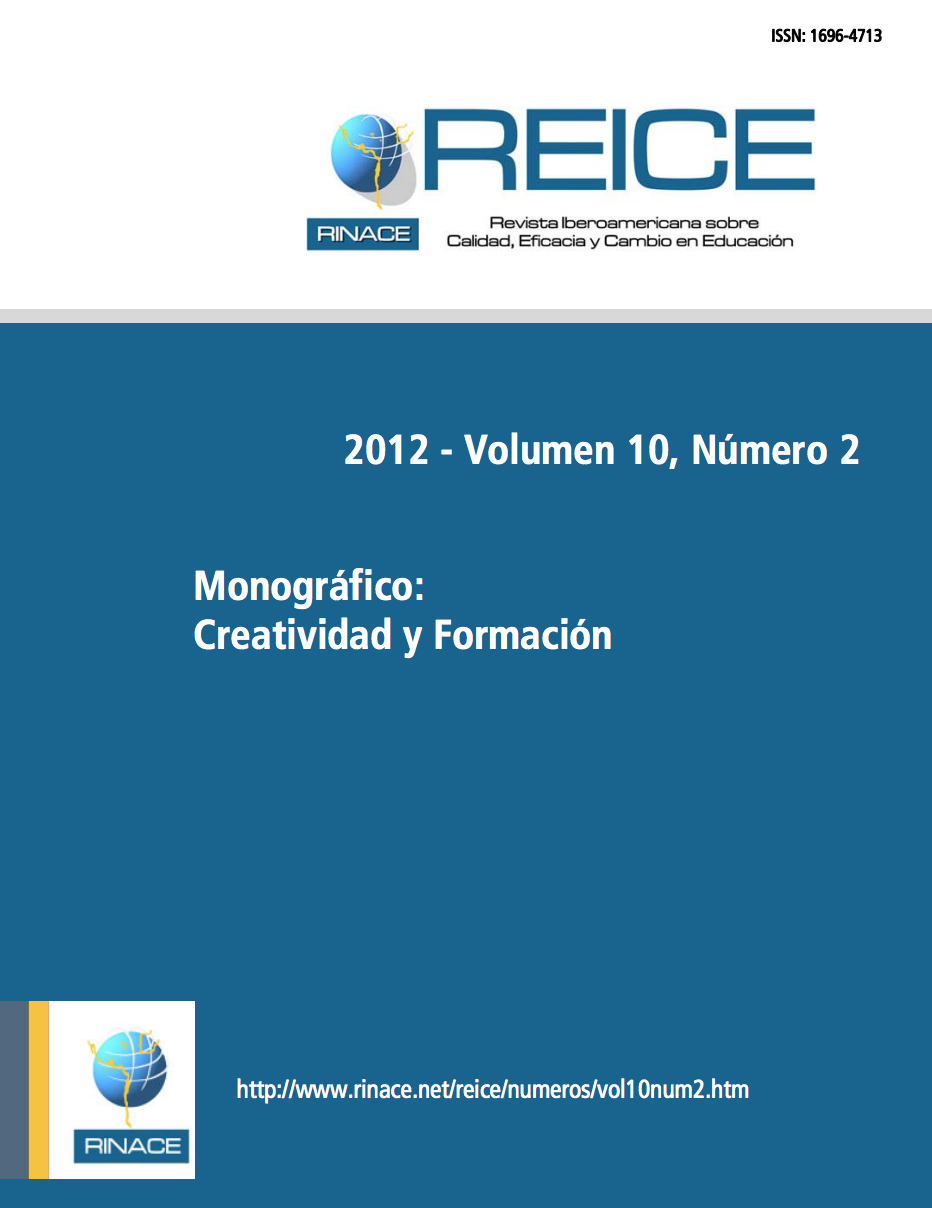Keywords:
Quality, Effectiveness, Change, Improvement, Equity, InnovationCopyright (c) 2016 REICE. Revista Iberoamericana sobre Calidad, Eficacia y Cambio en Educación

This work is licensed under a Creative Commons Attribution-NonCommercial-NoDerivatives 4.0 International License.
Abstract
This paper presents the research study conducted in the Basque Country, as part of a broader European project, denominated Creanova, which team brings together people from different institutions and agencies from eight European countries. Its main aim has been to identify and understand which factors and conditions are required to enhance creative competence and to promote creativity and innovation culture in such diverse fields as Vocational Education and Training (VET), adult education and workplace learning. The general research is structured in two phases: a) Analysis of fifty best practices in six countries (Basque Country, Finland, Ireland, Scotland, Italy and Estonia) and elaboration of a educational model for the analysis and development of creative competences, b) Application of the educational model in four real educational contexts (Basque Country, Finland, Scotland and Italy). The educational model developed has identify four categories (need, interaction, freedom and environment) which bind elements and conditions that stimulate creativity as part of learning. The experimental analysis reveals that: a) The four factors are dimensions that organize the educational practice and they may be considered a tool for designing and analyzing practices that foster creativity, b) They enable the articulation of theory and practice in specific cultural contexts, and c) This model, as a tool, is simple and understandable for those involved in learning processes (formal, non formal and workplace context).
Downloads
References
Amabile, T.M., Conti, R.. Coon, H., Lazenby, J. y Herron, M. (1996). Assessing the Work Environment for Creativity. The Academy of Management Journal, 39(5), 1154-1184.
Aubert, A., Flecha, A., García, C., Flecha, R. y Racionero, S. (2008). Aprendizaje dialógico en la sociedad de la información. Barcelona: Hipatia.
Aubert, A., Duque, E., Fisas, M. y Valls, R. (2004). Dialogar y transformar. Pedagogía crítica del siglo XXI. Barcelona: Graó.
Beck, U., Giddens, A. y Lash, S. (1997). Modernización reflexiva. Política, transición y estética en el orden social moderno. Barcelona: Península.
Beck, U. (1998). La sociedad del riesgo: hacia una nueva modernidad. Barcelona: Paidós.
Carneiro, R. (2007). The Big picture: understanding learning and meta-learning challenges. European Journal of Education, 42(2).
Clark, B. (2007). Growing Up Gifted: Developing the Potential of Children at Home and at School. NJ:Prentice Hall.
Craft, A. 2003. The Limits to Creativity in Education: Dilemmas for the Educator. British Journal of Educational Studies, 51(2), 113-127.
CREANOVA (2010). Discovering Vision. www.creanova-project.eu
CREANOVA (2011). Who could innovate alone? Documental dirigido por Aino Suni, Tampere University of Applied Sciences/School of Arts and Media (Finland). http://www.creanova-project.eu/publications-creanova.ph
Csikszentmihalyi, M. (1996). Creativity: Flow and the Psychology of Discovery and Invention, New York: HarperPerennial.
Csikszentmihaly, M. (2003). Fluir en los negocios: liderazgo y creación en el mundo de la empresa. Edit. Kairós.
Chomsky, N. (1977). El lenguaje y el entendimiento. Barcelona: Seix Barral
Chomsky, N. (2001). La (des)educación. Barcelona: Crítica.
Cropley, A. J. and Cropley D. H. (2009). Fostering Creativity: A Diagnostic Approach for Higher Education and Organisations. NJ:Hampton Press.
De Bono, E. (2008). Seis sombreros para pensar. Barcelona: Paidós.
Engeström, Y. (1987). Learning by Expanding. An Activity Theoretical Approach to Developmental Research. Helsinki: Orienta Konsultit.
Engeström, Y. (2004). Managing as argumentative history-making. In R. Boland (Ed.), Managing as designing. Stanford: Stanford University Press.
Fernández, I. et al. (2011). Sharing Strategies for a Creative and Sustainable Learning: CREANOVA in the Basque Country. EDEN 2011 Learning and Sustainability. The New Ecosystem of Innovation and Knowledge. Dublin
Fagerberg, J. (2003): Innovation: A Guide to the Literature. Centre for Technology, Innovation and Culture. University of Oslo. http://folk.uio.no/janf/downloadable_papers/03fagerberg_innovation_ottawa.pdf
Freire, P. (1970). Pedagogía del oprimido. Madrid: Siglo XXI.
Freire, P. (1990). La naturaleza política de la educación. Barcelona: Paidós.
Freire, P. (1997). A la Sombra de este Árbol. Barcelona: El Roure.
Gardner, H.; Csikszentmihaly, M.; Damon, W. (2002). Buen trabajo. Cuando ética y excelencia convergen. Barcelona: Paidós Transiciones.
Giddens, A. (1995). Modernidad e identidad del yo. Barcelona: Península.
Habermas, J. (1987). Teoría de la acción comunicativa .Vo l . I y II. Madrid: Taurus.
Hargreaves, A. (2003). Enseñar en la sociedad del conocimiento. Barcelona: Octaedro.
Mouleart, F., Martinelli, F., Swyngedow, E. y Gonzales, S. (2005). Towards Alternative Model(s) of Local Innovation. Urban Studies, 42(11) 1969-1990.
Mulgan, G. (2006). The Process of Social Innovation. http://www.policyinnovations.org/ideas/policy_library/data/TheProcessofSocialInnovation/_res/id=sa_File1/INNOV0102_p145-162_mulgan.pdf
Mulgan, G., Tucker, S., Ali. R. Y Sanders, B. (2007). Social innovation. What It Is, Why It Matters and How It Can Be Accelerated. Skoll Centre for Social Entrepreneurship. Working paper, http://www.youngfoundation.org/files/images/03_07_What_it_is__SAID_.pdf
Mumford, M.D. (2002). Social Innovation: Ten Cases From Benjamin Franklin, Creativity Research Journal, 14(2), 253-266.
Mumford, M.D. and Moertl, P. (2003). Cases of Social Innovation: Lessons from Two Innovations in the 20th Century”. Creativity Research Journal, 15(2&3), 261-266.
Piirto, J. (2004). Understanding Creativity. Arizona: Great Potential Press.
Vigotsky, L. (1995). Pensamiento y lenguaje. Barcelona: Paidós
Vigotsky, L. (2006). Teoría de las emociones. Madrid: Akal.
